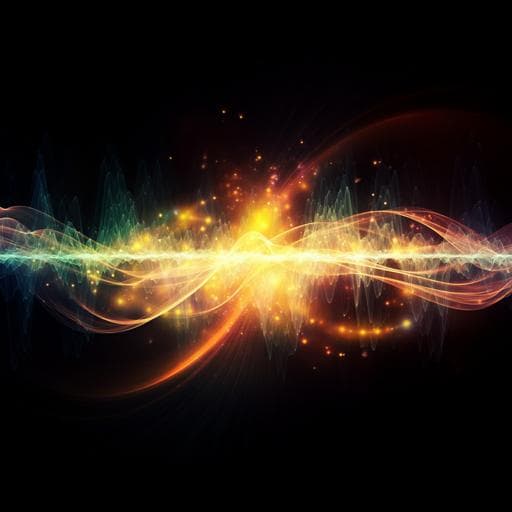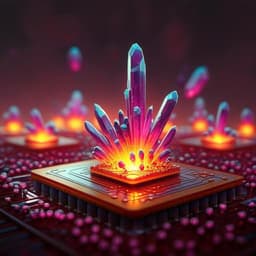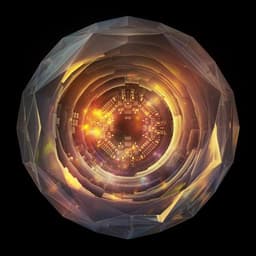
Physics
Observation of large spontaneous emission rate enhancement of quantum dots in a broken-symmetry slow-light waveguide
H. Siampour, C. O'rourke, et al.
This groundbreaking research by Hamidreza Siampour and colleagues showcases a nanophotonic waveguide platform with embedded quantum dots that enable significant Purcell-enhanced emission and remarkable chiral coupling. The study reveals record radiative decay rates and highlights the transformative potential of quantum dots in scalable on-chip spin-photonics. Join us to explore the future of photonics!
~3 min • Beginner • English
Introduction
The spontaneous emission rate of a quantum emitter can be modified by its photonic environment (Purcell effect). Integrating emitters into photonic-crystal waveguides (PCWs) enables on-chip Purcell enhancement by exploiting slow-light near the band edge, where a large group index increases the emission rate. Prior work in W1 PCWs reported up to 6.28 ns⁻¹ emission rates with roughly 9-fold Purcell enhancement and near-unity coupling efficiency (β ≈ 98.4%), indicating high cooperativity suitable for scalable architectures. Beyond emission rate enhancement, waveguides can support chiral coupling, where circularly polarized dipoles at chiral points couple directionally to guided modes, enabling spin-dependent photon routing necessary for chiral quantum optics and spin-photon networks. However, achieving simultaneously high chiral coupling and strong Purcell enhancement has been challenging because maximal directionality typically occurs away from field maxima. Glide-plane symmetry PCWs have been proposed to co-localize slow light and chiral fields, but previous experiments achieved only about 2-fold Purcell enhancement for chirally coupled dots. This work addresses this gap by demonstrating record Purcell factors for non-chiral and chiral QDs in glide-plane PCWs via precise spectral tuning using electric and magnetic fields, and by employing quasi-resonant phonon-sideband excitation to reveal the intrinsic radiative lifetime.
Literature Review
- Photonic nanostructures (micro/nano-cavities, dielectric nanoantennas, plasmonic structures) have been used to enhance emission rates and produce bright single-photon sources, aiding indistinguishable photon generation by mitigating dephasing.
- In PCWs, Purcell enhancement scales with group index and peaks near the photonic band edge in the slow-light regime. W1 waveguides have achieved up to 9-fold Purcell enhancement and β ≈ 98.4%.
- Alternative designs include topological slow-light PCWs, with recent reports up to 12-fold enhancement in triangular nanohole lattices with bearded interfaces.
- Chiral coupling demonstrated in nanobeams, glide-plane PCWs, and topological PCWs enables directional spin-photon interfaces. However, previous experiments typically observed low Purcell factors at chiral points due to low field intensity regions.
- Prior glide-plane implementations for chiral coupling reported ~2-fold Purcell enhancements, leaving room to achieve high directionality with strong emission-rate enhancement simultaneously.
Methodology
- Device design and fabrication: Glide-plane photonic crystal waveguides (PCWs) were patterned in GaAs membranes with embedded self-assembled InGaAs QDs in a p-i-n diode structure. The glide-plane line defect creates two parallel propagating modes whose dispersion curves cross at the band edge, broadening the slow-light region and avoiding a sharp cutoff. Slow-to-fast waveguide adaptors connect to nanobeam waveguides terminated with grating outcouplers. Multiple devices with band edges across 880–940 nm were fabricated.
- Electrical and magnetic tuning: Electrical contacts to p- and n-GaAs allowed Stark tuning over ~2.7 nm. A Faraday-geometry magnetic field up to 4.5 T (out-of-plane) split σ+/σ− Zeeman components, enabling chirality measurements and additional spectral tuning. Measurements were performed at 4.2 K in a helium bath cryostat with a superconducting magnet.
- Simulation and mapping: Finite-element/electromagnetic simulations mapped spatial Purcell factors and chiral regions (degree of circular polarization via Stokes parameters) versus emitter position relative to air holes. Near the band edge at ng ≈ 100, large Purcell enhancements (up to ~30) are predicted for emitters near the line defect close to holes, acknowledging a ~40 nm ‘dead zone’ from holes. Simulations show overlap regions allowing concurrent high chirality and Purcell enhancement.
- Identifying slow-light region: Ensemble excitation near one outcoupler and transmission detection at the opposite outcoupler identified adaptor band gaps and slow-light regions by comparison with simulated band structures.
- Lifetime measurements: Time-resolved photoluminescence using a mode-locked Ti:sapphire laser (82 MHz). Two excitation schemes:
• Non-resonant above-band excitation at 808 nm (sufficient for lifetimes ≥200 ps).
• Quasi-resonant phonon-sideband excitation: pulsed laser detuned by ~2 meV to excite the LA-phonon sideband, providing rapid (few-ps) population of the target excitonic state and revealing the radiative lifetime by eliminating intradot relaxation bottlenecks. Pulse shaping (4f shaper) produced ~6 ps pulses with ~160 GHz bandwidth; ultra-narrow band-pass filtering rejected pump leakage.
Additional weak non-resonant CW excitation (~150 nW) optimized contrast for quasi-resonant measurements.
- Detection: Superconducting nanowire single-photon detectors (SNSPDs) with instrument response down to 20 ps; time-correlated single-photon counting (Becker & Hickl SPC-130-EM). Hanbury Brown–Twiss (HBT) measurements verified single-photon emission (detector response ~114 ps for off-resonant excitation).
- Chiral coupling measurements: Out-of-plane magnetic field produced oppositely polarized Zeeman components; direction-resolved collection from left/right outcouplers revealed directional emission associated with σ+/σ− transitions. Bias tuning brought selected QDs near the slow-light band edge for Purcell characterization.
Key Findings
- Record-fast radiative decay for a non-chiral dot in a glide-plane PCW: Γ = 17 ± 2 ns⁻¹ corresponding to a lifetime of 60 ± 6 ps and a Purcell enhancement of 20 ± 2 relative to a bulk ensemble lifetime of 1200 ± 30 ps.
- Achieved by electric-field tuning to the slow-light region and quasi-resonant LA-phonon sideband excitation, which eliminated intradot relaxation delays.
- Wavelength-dependent decay rate measurements show lifetimes shorten as the QD is tuned toward the band edge; quasi-resonant excitation yields shorter lifetimes than above-band excitation at comparable detuning.
- Single-photon emission confirmed: HBT measurements yield g²(0) ≈ 0.11 (deconvolved) near the band edge and raw g²(0) ≈ 0.16 when slightly detuned (~200 ps lifetime case).
- Strong chiral coupling observed for multiple QDs across devices: oppositely polarized Zeeman components route to opposite propagation directions, consistent with chiral points predicted by simulations.
- Chirally coupled dot near slow light showed Purcell enhancement of 5 ± 1. For one device with band edge ~879 nm, lifetime reduced from 420 ps at 874.4 nm (detuning 4.6 nm) to 255 ps at 876.1 nm (detuning 2.9 nm) under non-resonant excitation; relative to ensemble lifetime, this corresponds to a 5-fold rate enhancement.
- Simulations indicate regions of overlapping high chirality and high Purcell factor in glide-plane PCWs; theoretical performance metrics for the platform include A ≈ 36% area with >90% circularity, Fp ≈ 30, and β ≈ 99%.
- The demonstrated 5-fold Purcell enhancement for a chirally coupled QD substantially exceeds previous reports in nanobeams, nanofibers, and other PCWs, including modified glide-plane designs.
Discussion
The study demonstrates that slow-light engineering in glide-plane PCWs enables strong light–matter interaction while preserving and exploiting chiral coupling between emitter spin states and guided modes. By tuning QD emission into the slow-light region and using phonon-assisted quasi-resonant excitation, the intrinsic radiative lifetime is revealed, yielding a 20-fold Purcell enhancement for a non-chiral dot. Simultaneously, the glide-plane symmetry provides spatial regions where high field intensity overlaps with strong circular polarization, enabling chiral routing with significant rate enhancement. These combined capabilities address key requirements for scalable spin-photonic interfaces: fast radiative rates to mitigate dephasing and improve indistinguishability, high β-factor for efficient on-chip extraction, and directional coupling for spin-controlled routing. The results surpass prior chiral demonstrations and illustrate a clear pathway toward integrated, scalable chiral quantum optics and spin-photon networks on a chip.
Conclusion
Glide-plane photonic crystal waveguides with embedded InGaAs QDs enable concurrent slow-light Purcell enhancement and chiral spin–photon coupling. A record radiative decay rate of 17 ± 2 ns⁻¹ (60 ± 6 ps lifetime) corresponding to a 20 ± 2-fold Purcell factor was achieved via electric-field tuning and phonon-sideband quasi-resonant excitation. For a chirally coupled QD, a 5 ± 1-fold Purcell enhancement with strong directional emission of Zeeman components was demonstrated, outperforming previous chiral platforms. These results establish glide-plane PCWs as a promising platform for on-chip chiral quantum optics and scalable photonic quantum technologies. Future advances will focus on positioning QDs closer to optimal high-field chiral regions and improving spectral tuning to reach even higher Purcell factors for chirally coupled emitters, as well as integrating multiple emitters for quantum networking.
Limitations
- Spatial mismatch: The absolute maxima of Purcell enhancement and chirality occur in different regions; only partial overlap exists, requiring precise emitter positioning near air holes while avoiding dead zones (~40 nm from holes).
- Spectral tuning constraints: Electrical tuning range (~2.7 nm) limited how closely chirally coupled dots could be brought to the band edge, reducing achievable Purcell factors in chiral demonstrations.
- Random emitter distribution: Self-assembled QDs have random positions and inhomogeneous emission frequencies, necessitating screening and limiting yield of optimally located/tuned dots.
- Measurement considerations: For fastest decays, quasi-resonant phonon-sideband excitation was essential to avoid relaxation bottlenecks; non-resonant methods can overestimate lifetimes. Detector response influences rise-time dynamics though not extracted lifetimes.
- Generalizability: Results depend on device-specific band-edge engineering and adaptor design; performance may vary across fabrication batches and spectral bands.
Related Publications
Explore these studies to deepen your understanding of the subject.







